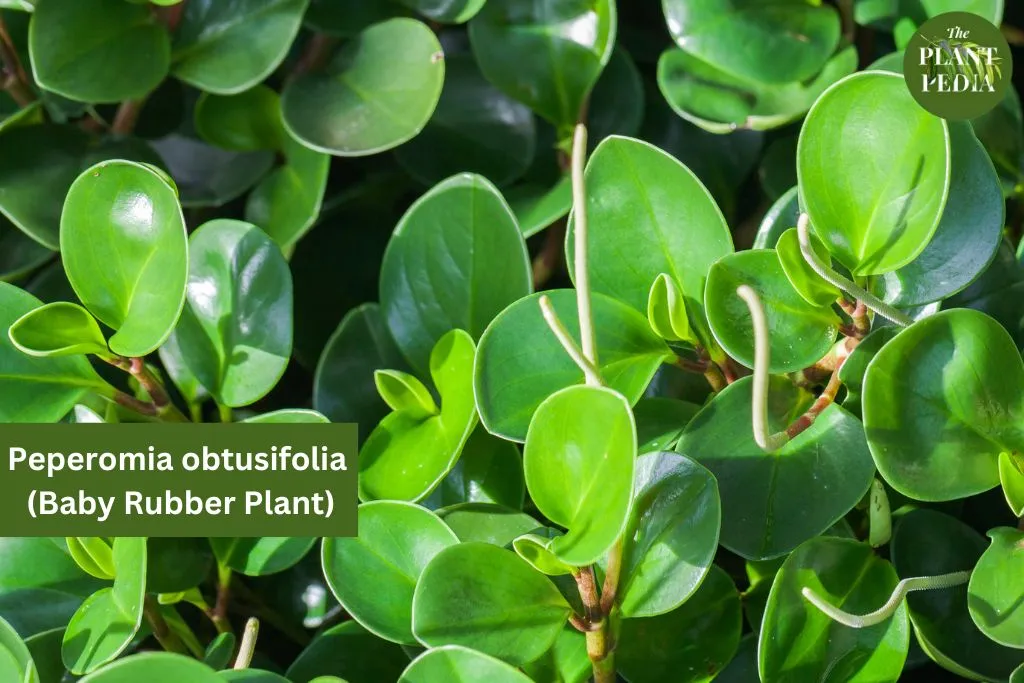Indoor plants have gained immense popularity over the years, not only for their aesthetic appeal but also for their air-purifying qualities and ability to bring nature indoors.
One such beloved plant is the Peperomia obtusifolia, commonly known as the Baby Rubber Plant or American rubber plant. With its unique appearance, ease of care, and variety of cultivars, this plant has captured the hearts of plant enthusiasts around the world.
In this comprehensive guide, we will explore everything you need to know about Peperomia obtusifolia, from its appearance and care requirements to its various cultivars and propagation methods.
What is a Peperomia Obtusifolia (Baby Rubber Plant)?
Peperomia obtusifolia, commonly known as the Baby Rubber Plant, is a captivating indoor plant that belongs to the Peperomia family.
Native to South America, this plant has gained popularity for its unique appearance, ease of care, and variety of cultivars.
Its common name, “Baby Rubber Plant,” is derived from its thick, rubbery leaves that share a slight resemblance to those of the rubber tree (Ficus elastic).
With its compact and bushy growth habit, the Peperomia obtusifolia is an excellent choice for small spaces and decorative containers.
Read in Depth: Baby Rubber Plant Care – Tips and Techniques.

What Does the Peperomia Obtusifolia Look Like?
The Peperomia obtusifolia, or Baby Rubber Plant, boasts a distinct and charming appearance that sets it apart from other indoor plants.
Its unique features contribute to its widespread popularity among plant enthusiasts. Let’s take a closer look at the characteristics that define the visual appeal of this captivating plant.
Leaf Shape and Size:
The most noticeable feature of the Peperomia obtusifolia is its thick, succulent-like leaves. These leaves are typically oval or elliptical in shape, with a slightly rounded or blunt tip, which gives rise to the plant’s specific name “obtusifolia” (obtuse leaves).
The leaves vary in size, generally reaching around 2 to 4 inches in length. This size, combined with the compact growth habit, creates a dense and bushy appearance that is both attractive and easy to manage.
Leaf Coloration and Variability:
One of the most captivating aspects of the Peperomia obtusifolia is the wide range of leaf colors and patterns it exhibits.
The base leaf color is usually a deep shade of green, which serves as a backdrop for various variegation patterns.
These variegations can manifest as stripes, spots, or marbling in shades of cream, white, yellow, or even pink.
Each leaf can display a unique combination of these colors, adding a dynamic and visually appealing element to the plant’s overall appearance.
Read: Peperomia Obtusifolia Variegata: Everything About This Beauty.
Growth Habit:
The Baby Rubber Plant has a compact and bushy growth habit, making it a favorite choice for indoor spaces with limited room.
As the plant matures, it produces multiple stems, creating a fuller and more voluminous appearance.
This growth habit makes it an excellent candidate for small decorative containers, tabletops, and shelves, where it can flourish without taking up excessive space.
Aesthetic Adaptability:
Peperomia obtusifolia’s aesthetic adaptability is one of its standout features. Whether you prefer a classic look with deep green leaves, a subtle touch of variegation, or a burst of vibrant colors, there’s a cultivar to suit your taste.
The various cultivars, such as ‘Green,’ ‘Variegata,’ ‘Alba,’ ‘Golden Gate,’ and ‘Lemon Lime,’ offer a spectrum of visual options to match your interior design style and personal preferences.
Read: Peperomia Obtusifolia Flower: Exploring the Enigmatic Beauty.
Cultivars and Varieties
Peperomia obtusifolia has several cultivars and varieties, each with its own unique appearance and characteristics. Some of the most popular ones include:
- Peperomia obtusifolia ‘Green’: This is the classic variety, known for its deep green leaves and compact growth habit. It’s a great choice for beginners due to its low-maintenance nature.
- Peperomia obtusifolia ‘Variegata’: This variety features leaves with striking variegation, often in shades of cream, white, or yellow. It adds a touch of brightness to any indoor space.
- Peperomia obtusifolia ‘Alba’: ‘Alba’ has leaves with a predominantly creamy white color, creating a subtle and elegant look that complements various interior styles.
- Peperomia obtusifolia ‘Golden Gate’: This cultivar showcases leaves with a mix of green, cream, and shades of pink. The colorful foliage adds a playful and vibrant element to your indoor garden.
- Peperomia obtusifolia ‘Lemon Lime’: As the name suggests, this variety boasts leaves in shades of lemony green, making it a refreshing choice for those who prefer brighter colors.
Care Requirements
One of the reasons why Peperomia obtusifolia is so popular is its relatively easy care requirements. Here’s a breakdown of what you need to know to keep your Baby Rubber Plant thriving:
Light: These plants prefer moderate to bright indirect light. Avoid placing them in direct sunlight, as it can scorch their leaves. If you notice the plant becoming leggy or stretching towards the light, consider moving it to a slightly brighter spot.
Watering: Allow the top inch or so of the soil to dry out before watering. Overwatering can lead to root rot, so it’s crucial to let the soil dry between waterings. Watering once a week during the growing season (spring and summer) and reducing frequency in the dormant season (fall and winter) is generally recommended.
Humidity: Peperomia obtusifolia enjoys higher humidity levels, but it can tolerate average household humidity. If you notice the tips of the leaves turning brown, it could be a sign that the air is too dry.
Temperature: These plants thrive in typical indoor temperatures between 65°F to 75°F (18°C to 24°C). Avoid exposing them to extreme cold drafts or sudden temperature changes.
Soil: Use a well-draining, lightweight potting mix that allows excess water to escape. You can also consider adding perlite or orchid bark to the mix to improve drainage.
Fertilization: During the growing season, feed your Peperomia obtusifolia with a balanced, water-soluble fertilizer every 4-6 weeks. Dilute the fertilizer to half or a quarter of the recommended strength to prevent overfeeding.
Propagation
Propagating Peperomia obtusifolia can be an exciting way to expand your plant collection or share this delightful plant with friends. There are a few methods you can try:
1. Leaf Cuttings: This is the most common propagation method for Peperomias. Simply take a healthy leaf with its stem attached and allow it to callous for a day or two. Then, plant it in a well-draining rooting medium and keep it in a humid environment until roots form.
2. Stem Cuttings: You can also take stem cuttings with a few leaves attached. Plant the cuttings in a similar manner as leaf cuttings and follow the same rooting process.
3. Division: As the plant grows, it may develop multiple stems. You can gently separate these stems from the main plant and repot them individually.
Common Issues and Troubleshooting
Even though Peperomia obtusifolia is relatively low-maintenance, it’s essential to be aware of potential issues and how to address them:
1. Overwatering: This is perhaps the most common mistake. Ensure the soil dries out between waterings to prevent root rot.
2. Underwatering: While these plants are tolerant of drying out occasionally, consistently letting them become too dry can lead to stress and leaf drop.
3. Pests: Keep an eye out for common houseplant pests like mealybugs and spider mites. Regularly inspect the leaves and stems, and if you notice any pests, treat them promptly with insecticidal soap or neem oil.
4. Leggy Growth: If your Peperomia becomes leggy, it might not be receiving enough light. Move it to a brighter spot and consider pruning to encourage bushier growth.
5. Yellowing Leaves: Yellow leaves can be a sign of overwatering, underwatering, or even exposure to cold drafts. Evaluate the plant’s care conditions to determine the cause.
Read: How to Prune Baby Rubber Plant for Optimal Growth and Beauty.
Related FAQs:
How often should I water my Peperomia obtusifolia?
The frequency of watering depends on various factors, including the temperature, humidity, and the type of potting mix used. In general, allow the top inch or so of the soil to dry out before watering.
It’s better to underwater than overwater, as these plants are sensitive to soggy soil, which can lead to root rot. During the active growing season (spring and summer), you may need to water approximately once a week.
In the dormant season (fall and winter), reduce watering frequency.
Can I place my Peperomia obtusifolia in direct sunlight?
While Peperomia obtusifolia can tolerate some direct sunlight, it’s best to avoid placing it in intense, full sun.
Direct sunlight can scorch the leaves and cause damage. Instead, opt for bright indirect light, such as near a north- or east-facing window.
If you notice the plant becoming leggy or stretching towards the light, consider moving it to a slightly brighter spot.
How can I propagate my Peperomia obtusifolia?
Peperomia obtusifolia can be propagated through various methods, including leaf cuttings, stem cuttings, and division.
For leaf cuttings, simply snip a healthy leaf with its stem attached and allow it to callous for a day or two. Plant the leaf in a well-draining rooting medium and keep it in a humid environment until roots form.
Stem cuttings can be taken with a few leaves attached and rooted in a similar manner. Division involves separating multiple stems from the main plant and repotting them individually.
Why are the tips of my Peperomia’s leaves turning brown?
Brown tips on the leaves can be caused by several factors, including low humidity, underwatering, or exposure to drafts.
Peperomia obtusifolia appreciates higher humidity levels, so consider misting the plant or using a humidity tray to maintain adequate moisture around the leaves.
Ensure you’re watering the plant appropriately and that it’s not being exposed to cold drafts.
How can I encourage bushier growth in my Peperomia obtusifolia?
If your Peperomia becomes leggy with sparse growth, it might be an indication that it’s not receiving enough light. Move the plant to a brighter location, ensuring it’s not exposed to direct sunlight.
Additionally, to encourage bushier growth, consider pinching or pruning the tips of the stems. This will prompt the plant to produce new growth from the nodes, resulting in a fuller appearance.
Are there any common pests that affect Peperomia obtusifolia?
Yes, like many indoor plants, Peperomia obtusifolia can be susceptible to pests such as mealybugs, spider mites, and aphids.
Regularly inspect the leaves and stems for signs of pests, such as webbing, tiny insects, or discolored patches. If you notice any infestations, isolate the plant from others and treat it promptly with insecticidal soap or neem oil.
Quarantine newly acquired plants before introducing them to your collection to prevent the spread of pests.
Can I fertilize my Peperomia obtusifolia? If so, how often?
Yes, you can fertilize your Peperomia obtusifolia to promote healthy growth and vibrant foliage.
During the growing season (spring and summer), you can use a balanced, water-soluble fertilizer diluted to half or a quarter of the recommended strength.
Apply the fertilizer every 4-6 weeks to provide the plant with essential nutrients. Reduce or stop fertilizing during the dormant season.
Is Peperomia obtusifolia safe for pets?
Peperomia obtusifolia is generally considered non-toxic to cats, dogs, and humans.
However, it’s always a good practice to keep plants out of reach of curious pets to prevent accidental ingestion, as individual sensitivities can vary.
Conclusion
Peperomia obtusifolia, the Baby Rubber Plant, is a charming addition to any indoor plant collection.
Its distinctive appearance, ease of care, and variety of cultivars make it an ideal choice for both beginners and experienced plant enthusiasts.
By providing the right amount of light, water, and attention to its care, you can enjoy the beauty of this plant and watch it thrive in your home.
Whether you opt for the classic ‘Green’ variety or explore the world of variegated and colorful cultivars, the Peperomia obtusifolia is sure to bring a touch of nature’s elegance to your living space.
